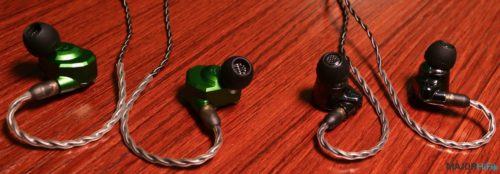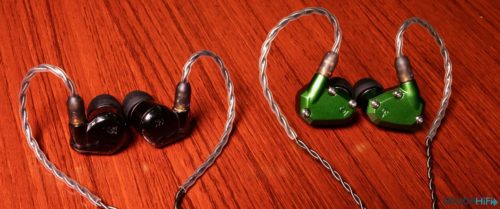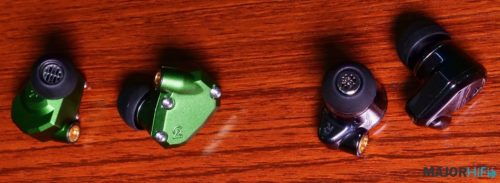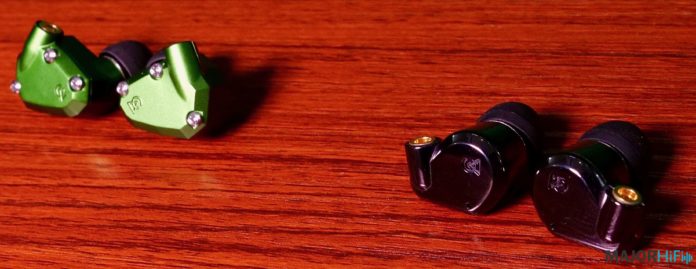Campfire Audio has gained increasing prestige in the IEM game as they’ve continued to release new products. Their prices tend to be on the higher side, but they’re a brand that many trust to ensure you’ll get what you pay for. The Andromeda is one of their most popular models, but equally priced to it at $1,099 is their Dorado model, a hybrid IEM (I recently posted a video review of the Dorado if you’d like to watch it). The two of these felt deserving of comparison, as I’m sure many are torn between to the two.

Design
The most notable difference between these IEMs is that the Dorado is a hybrid IEM containing a dynamic driver for the mid and low and a balanced armature driver for its high. The Andromeda, on the other hand, uses two balanced armature drivers for its high, two for its low, and one for its mid. The Andromeda also features Campfire Audio’s Tuned Acoustic Expansion Chamber to help it deliver extended high end in a clean manor. Both feature custom beryllium/copper MMCX connections.
Andromeda: 10Hz – 28kHz Frequency Response / 12.8 Ohms impedance
Dorado: 5Hz – 22kHz Frequency Response / 10 Ohms Impedance

Look and Feel
The Andromeda has a much more angular, geometric shape to its body than the curved, smoothed form the Dorado takes on. In terms of color, the Andromeda makes a bit bolder of a statement with its metallic green, whereas the Dorado has a more dramatic look with its mirrored dark grey finish. Both are equally comfortable, though the softer edges on the Dorado make them slightly easier to situate at times.

Soundstage
To me these both felt wider back to front than they did right to left. There’s plenty of width but a bit more overall depth. The Andromeda appears to have slightly more width and distinct separation than the Dorado, and both feel more geared towards a hefty, built sound than something intensely feathered out. I’d say in terms of 3 dimensionality these both feel on par with their competition, and have a very well conveyed stereo field. They certainly don’t skimp on any front in terms of their width or imaging.
Highs
The Andromeda is notably brighter than the Dorado, though neither is dark on its own. The Andromeda has a full fledged brightness to it, and gives an extra serving of definition to many songs. Many elements get a modernized coloring and snap to them, but sharper edges are avoided by keeping the more splitting frequencies from making too much of an appearance, without decimating the high end in cuts.
The Dorado’s high end doesn’t feel like a very far cry from that of the Andromeda, though it’s definitely less intense in the 16k range and has a little less of a direct shine to it. They share a similarly smooth, modern coloring, but the Dorado feels warmer and less high-end focused than the Andromeda. The Dorado definetly has a more filtered, modulated high end, making for a more specified, less obvious sheen.
I listened to “Set Me On Fire” by reggae artist Sevana on both IEMs. The Andromeda pulled a lot of the breathiness forward from its backing vocals and painted a noticeable glitz onto the strings while adding some extra pop to the snares and other percussion. The Dorado felt like it gave equal presence to all these elements as the Andromeda did, but did with a lighter touch and more warmth.
Mids
The Dorado has a small resonant boost in the midrange, giving them a healthy dose of cutting presence. However, they overall have a more rounded mid response. Their high-mids are very selectively taken advantage of whereas the low mids are given much more heft across the board. They have a satisfying bite, especially gratifying in how consistently easy on the ears it is. The sound never feels buried but also avoids any sharp stabs. It’s a mid range you can trust to engage you within reason.
Comparitvely, the Andromeda is less selective in its boosts but equally clean and refined as the Dorado. It shares a light resonance in its mid range, but the high mid seems to be more consistently present, making for a brighter, more shining timbre. The Dorado feels slightly V shaped compared to the Andromeda, but not so much on its own. Both have the same taming, quelled coloring. The Andromeda is a noticeably shinier sounding IEM, but once you’re used to either one they both come across with plenty of snap and bite.
Lows
Both the Andromeda and Dorado have wild running, cinematic lows. The Dorado, however, is much more focused on the basement sub frequencies. While the Andromeda still pays its dues to the sub range, it seems to take more advantage of the low end a bit further upwards. I played “All is Full of Love” by Björk and both IEMs gave a hard hitting portrayal of the booming track. The Dorado seemed to isolate the heavy kick drum more whereas the Andromeda seemed to blend it in with low mid elements and marry it to the mix a bit more. The Andromeda felt like it held a tighter grip on the songs low end whereas the Dorado gave it more room to stomp. I enjoyed both presentations, and would probably choose either depending on my mood. The Dorado offered more of a satisfying sensation and body in the low whereas the Andromeda offered more balance and containment.

Overall
These are both extremely impressive IEMs whose characters draws your eyes away from their price point and ears deep into their sound. They have distinctly different sounds but do share a similar Campfire Audio tonality overall. Which one you prefer is definitely a matter of preference, and neither will disappoint. Even with their clear differences, their equally high quality sounds make them still hard to choose between.
You can purchase Campfire Audio’s Andromeda and Dorado at Audio46
Compare the ranking of various headphones, earbuds and in-ear monitors using our tools.
Discuss this, and much more, over on our forum.
---MAJORHIFI may receive commissions from retail offers.















